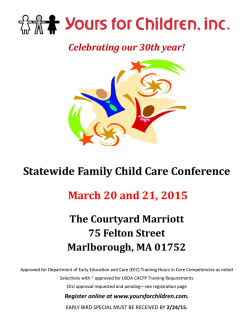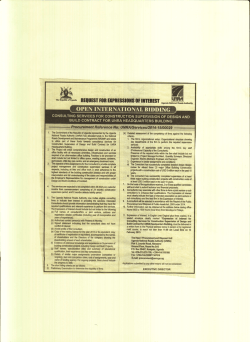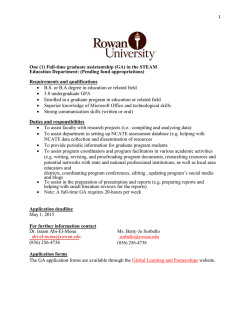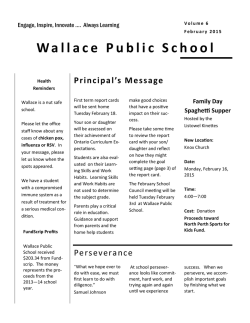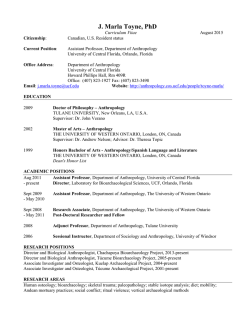
Newsletter - Anthropology - University of New Mexico
UNIVERSITY OF NEW MEXICO DEPARTMENT OF ANTHROPOLOGY NEWSLETTER WINTER 2014 Saki Tzul Rockshelter in the Bladen River Nature Reserve in Belize is one of the rockshelters targeted for iden fying early Holocene human ac vi es. BELIZE ROCKSHELTERS REVEAL HOLOCENE HUMAN ACTIVITY by Keith Prufer, Associate Professor Linda Cordell A er 10 years of excava ons at the Classic Maya center of Uxbenká in Belize, Keith Endowed Scholarship Prufer’s research is changing direc on and focusing on the earliest inhabitants of the tropical Central America rainforests. In Mesoamerica, despite a century of research very li le is known about Paleoamericans and Archaic foragers. Most of what is known comes from isolated surface finds that lack detailed context or from poorly dated excava ons da ng to the 1940s through the 1970s. Since 2011 and with funding from the Alphawood Founda on Prufer’s team has been excava ng at two rockshelters and along a river terrace that have revealed a con nuous human presence from 12,400 to 3,000 years ago based on a series of more than 15 AMS 14C dates. Working with a team of paleoecologists, paleoclimatologists, and bioarchaeologists from Penn State University, Durham University, ETH Zurich, University of Mississippi, and Central Washington University they have been analyzing human, animal, and other organic remains as well as stone tools from across all preceramic me periods. In February the UNM team consis ng of Prufer and PhD students Christopher Merriman and Clayton Meredith, as well as partners from Texas A&M University, LSU, the Belize Ins tute of Archaeology, and the Yaxche Conserva on Trust conducted excava ons at Mayahak Cab Pek Rockshelter in the Bladen Nature Reserve, a remote and undisturbed site two days walk from the nearest road. Preliminary data suggests that the shelter was an early Holocene burial site also used for extensive tool making and animal processing. Research plans for the coming year include refining the chronology of all three sites with an expanded suite of dates, beginning a stable isotope study of the faunal materials (which number in the 1000s of samples), ini a ng preliminary aDNA assessment of the human remains, and comple ng a detailed study of changes in stone tool technology across the early Holocene. Dr. Linda Cordell This scholarship established in 2014 by a past student, honors former faculty member and chair, Linda Cordell. Dr. Cordell conducted innova ve archaeological research in the American Southwest and mentored a genera on of graduate students in anthropology. Dr. Cordell taught at UNM from 1971 to 1987, directed the UNM Southwest Field Schools at Tijeras Canyon, Rowe Pueblo, and Teypama, and published a synthesis of Southwestern archaeology in her text Prehistory of the Southwest (1984). This endowment supports graduate scholarships for students in the Archaeology Program, especially those interested in the Southwest. Recipients will be selected by the Chair or his/her delegate. Click here to support this fund. Image le : Willa Trask (Texas A&M, far le ), UNM PhD student Clayton Meredith (top center) along with project collaborator excava ng the Paleoamerican and Archaic levels at Mayahak Cab Pek Rockshelter. WINTER 2014 ISSUE CHAIR'S CORNER A Message from the Chair: Outgoing and Incoming In This Issue Holocene Rockshelter......... 1 Cordell Scholarship ........... 1 Chair's Corner..................... 2 Stories from the Field......... 3 Ysleta del Sur Pueblo.......... 3 Student News/Awards..... 4-5 Archeology on Ice................5 Faculty Updates............... 6-7 Alumni News...................... 7 Donor Thanks..................... 7 Upcoming Events............... 7 Editorial Board Ann Braswell (Editor) Joann Comerford (Design) Jennifer George Michael Graves Bruce Huckell Lisa Huckell Ma Tu le For Further Informa on Contact Ann Braswell at (505) 277-4544, or [email protected] Publishing Informa on Anthropology Newsle er is published biannually in printed and electronic format by: The Department of Anthropology MSC01 1040 1 University of New Mexico Albuquerque, NM 87131 UNM ANTHROPOLOGY NEWS / PAGE 2 This will be my final Chair’s Corner. I step down in January 2015, a er comple ng 8 years in this posi on. I will return to my full me faculty posi on. I want to express my apprecia on to my colleagues and students in Anthropology as well as our friends on campus and around the country. The support and encouragement I received as Chair has been gra fying. I also want to thank Ann Braswell who has edited the biannual newsle er since my arrival. This is one of the highlights of our Department, allowing us to stay in touch with alumni and supporters. Please join me in welcoming Les Field, who will assume the posi on of Chair, January 1, 2015. Professor and Outgoing Chair Michael Graves Just a few words from Les Field. I have been a faculty member in the Ethnology sub-field since August 1994, and have on two occasions been the Associate Chair, most recently in the past several years. Since 2011, I have also been the Director of UNM's Peace Studies Program. In my teaching career, I have been dedicated to undergraduate educa on, and con nue to teach the introductory 101 class which enables me to reach the broadest possible cross-sec on of UNM's undergraduates. I have also mentored graduate students through the PhD program, and am always par cularly excited to work with students in geographical areas where I have also specialized: Nicaragua, Colombia, Na ve California, and Israel/Pales ne. As Chair, I intend to build on our departmental strengths in all three sub-fields, in both our research and teaching missions, and to support our faculty and students. Our department brings UNM to the world and the world to UNM; I look forward to the next three and half years as Chair of this historic and renowned department. Professor and Incoming Chair Les W. Field STORIES FROM THE FIELD By Marian Hamilton, PhD candidate, EvoluƟonary Anthropology Since I was a kid, it has been my mission in life to spend as much of the summer as possible outside. Usually I managed to be pre y successful, but this summer took it to a new level. Along with my advisor, Sherry Nelson, Assistant Professor, and Associate Professor Mar n Muller, I traveled to Kibale Na onal Park, Uganda to collect pilot data for my disserta on. Kibale is an incredible place: almost 300 square miles of evergreen rainforest, home to flourishing communi es of wild chimpanzees, red colobus monkeys, baboons, red river hogs, forest elephants, and some of the most spectacular birds imaginable. We had two working projects, both using isotopic signatures from plants and animal ssues to make inferences about how animals func on in their ecosystem. Models based on living primates in Kibale help us reconstruct ecologies of fossil species. For the first project, we wanted to use isotopes to track animal movement. To do this, we had to collect plant samples from as much of those 300 square miles as possible and build an isotopic “map” of the park. In a place with few roads, this was no easy task! We had two wonderful field assistants to help guide us on our many day-long treks through the forest, somemes without a trail. For the areas very far away from camp, we took some bone-ra ling drives along paths that the GPS told us should be roads. We managed to sample a large propor on of the park by the end of the summer, despite some close encounters with not-so-friendly elephants and green mambas. For the second project, we wanted to see if isotopic signatures in animal ssues varied based on how high in the canopy the animal foraged. Of course, to es mate the isotopic signature for a monkey who feeds on the highest leaves in the trees, we needed to get to those highest leaves ourselves. In Kibale, the top canopy layer is between 20–50 meters high. This conundrum found us at a 3-day tree climbing school in Denver, Colorado, where we Marian Hamilton climbing, learned how to launch ropes over branches with a 6-foot-tall slingshot, e photos by Sherry Nelson. (very) secure knots, and hoist ourselves hand-over-foot up the rope and into the trees. Climbing was not something I took to naturally. The first dozen or so mes, about fi een feet off the ground my stomach would drop and I would be sure that my rope was about to give out on me. Of course it never did, and eventually the feeling of dangling nearly 70 feet in the air was exhilara ng! You certainly couldn’t beat the view. We collected over 100 samples of fruits and leaves from the ground up in 20 of Kibale’s most beau ful trees. This summer was a success by all metrics, academic and personal. Based on the results from the pilot data, I hope to be back swinging through trees again next summer. Project funding: Na onal Science Founda on Graduate Research Fellowship (Grant #DGE-0903444) and the University of New Mexico, Office of Graduate Studies. Photo Voices at Ysleta del Sur Pueblo Beverly R. Singer, Director, Alfonso OrƟz Center for Intercultural Studies Sean Bruna with Photo Voices par cipants. In 2012, just as UNM anthropology graduate Sean Bruna (PhD 2013) was comple ng his disserta on about Ysleta del Sur Pueblo (YDSP) and diabetes, he submi ed a proposal on behalf of the YDSP Community Programs to the Or z Center for an a er school Youth Photo Voice Project. Bruna coordinated the project with Ariel Carrillo and Angel Montoya and worked with twelve youth ac vely teaching them more about their community history and par cipa ng in documentary photography workshops. The youth produced hundreds of photos and 25 photographs were selected for a permanent exhibit at the YDSP Community Health Clinic. The photo voices of the students focus primarily on places and loca ons that represent their awareness of their community. Special thanks to Dr. Sean Bruna who helped organize the project and to Blaire Topash Caldwell, current Hibben Fellow working with the Or z Center as a graduate student community liaison for comple ng the project and ge ng the photos delivered. The Tigua of Ysleta del Sur Pueblo are a federally recognized Indian tribe situated in close proximity to the ci es of El Paso and Socorro, Texas just north of Mexico along the Rio Grande. Tigua history began further north in their ancestral homelands of Abo, Gran Quivira, and Quarai. The result of the 1680 Pueblo Revolt forced a group of Tigua south and those that survived se led Ysleta where they built the Mission of Corpus Chris . Forced nego a ons with the state of Texas resulted in their lands becoming a checkerboard configura on with their primary reserva on located a mile northeast of the Zaragoza Interna onal border between the U.S. and Mexico. A majority of their popula on of 1,728 members reside on 2,698 acres of trust lands but the tribe also owns the Chilocote Ranch in Presidio and Jeff Davis County, Texas. UNM ANTHROPOLOGY NEWS / PAGE 3 STUDENT AWARDS, PRESENTATIONS AND PUBLICATIONS PhD recipient Helen E. Davis PhD Recipients Fall/Winter 2014 Helen E. Davis Variable Educa on Exposure and Cogni ve Task Performance among the Tsimané Forager-Hor culturalists, (Hillard Kaplan and Jane Lancaster, Co-chairs) Andrea M. Lopez (With Dis nc on) The Paradoxes of Poverty: Gendered Ideologies of Interven on in the “Compassionate City" of San Francisco, (Les Field and Louise Lamphere, Co-chairs) PhD recipient Andrea M. Lopez Masters of Science Summer/Fall 2014 Drew Enigk and Marian Hamilton Presenta ons and Publica ons Conrad, C. and Pastron, A. 2014. Galapagos Tortoises and Sea Turtles in Gold Rush-Era California. California History 91(2): 20–39. Conrad, C., Gobalet, K.W., Bruner, K. and Pastron, A. (In press, 2014). Hide, Tallow, and Terrapin: Gold Rush-Era Zooarchaeology at Thompson’s Cove (CA-SFR-186H), San Francisco, California. Interna onal Journal of Historical Archaeology. Straus, Lawrence Guy, Manuel R. González Morales, and Lisa M. Fontes. 2014. Ini al Magdalenian Ar fact Assemblages in El Mirón Cave (Ramales de la Victoria, Cantabria, Spain): A Preliminary Report. Zephyrus 73:45–65. Ragsdale C. S. and H. J. H. Edgar. (In press, 2014). Cultural Interac on and Biological Distance in Postclassic Period Mexico. American Journal of Physical Anthropology. Prufer, Keith M. and Amy E. Thompson. 2014 Se lements as Neighborhoods and Districts at Uxbenká: The Social Landscape of Maya Community. Research Reports in Belizean Archaeology 11: 281–89. Barron, Nicholas. "Fractured Sight: Viewing State Documents as Systems of Classifica on and Material-Semio c Performances of Power," Na ve American and Indigenous Studies Associa on (NAISA) Conference, Aus n, Texas, May, 2014. Barron, Nicholas. "'Expert' Witnesses and the Indian Claims Commission," Newberry Consor um in American Indian Studies (NCAIS) Conference, Chicago, IL, June 2014. Fontes, Lisa M. “Crea ng Mobile Patches: Lower Magdalenian Lithic Conveyance Systems in Cantabria (Spain).” 17th Internaonal Union of the Prehistoric and Protohistoric Sciences (IUPPS) Congress, Burgos, Spain, September 1–7, 2014. Davenport, James. "LA-ICP-MS Analysis of Inka and pre-Inka Ceramic Pigments from the Temple of the Sun, Pachacamac." 33rd Northeast Conference on Andean Archaeology and Ethnohistory, Burlington, VT, October 17–19, 2014. Davenport, James. “Provisioning state-sponsored ceremonies in the provinces: neutron ac va on analysis of Inka and pre-Inka ceramics from the Temple of the Sun, Pachacamac.”55th Annual Mee ng of the Ins tute of Andean Studies in Berkeley, California, January 9-10, 2015 Ragsdale, C. S., E. Melgar, and H. J. H. Edgar. “Analysis of the skull masks and offerings of the Templo Mayor: An Archaeological and Biological Approach.” 79th Annual Society for American Archaeology Mee ng, Aus n, Texas, April 23–26, 2014. Prufer, Keith M. and Amy E. Thompson. Evalua ng airborne LiDAR for detec ng se lements and modified landscapes in disturbed environments at Uxbenká, Belize. 79th Annual Society for American Archaeology Mee ng, Aus n, Texas, April 23—26, 2014. Thompson, Amy E., Eric C. Fries, and Keith M. Prufer. Local Varia on of Se lement Pa erns at Uxbenká and Ix Kuku’il, Toledo District, Belize. 79th Annual Society for American Archaeology Mee ng, Aus n, Texas, April 23–26, 2014 (poster). External & Department Graduate Awards Holly Brause received a LAII Field Research Grant (June/July 2014) for preliminary research on a project en tled Norteña Music and Transna onal Life; Cyler Conrad received a 14CHRONO Centre Radiocarbon Da ng Award from the Quaternary Research Associa on (Summer 2014) for Chronological, Zooarchaeological and Paleoenvironmental Reinves ga on of Banyan Valley Cave, Mae Hong Son Province, Northwest Thailand, a UNM Graduate Research Project and Travel Grant (Fall 2014), a UNM Student Conference Award (Fall 2014), and most recently a Na onal Geographic Young Explorers Grant for his project A Biogeographic and Isotopic Inves ga on of Modern and Ancient Mollusks on the Thai-Malay Peninsula (Summer 2015); Jill Jordan was awarded a Wenner Gren grant to support her disserta on research Inves ga ng Intracommunity Interac on at the Ancient Maya Sites of Baking Pot and Uxbenká, Belize; Corey Ragsdale received a Student Research Grant from the Graduate Professional Student Associa on for Research of Human Skeletal Remains in Merida, Yucatan, (June 2014), and a Field Research Grant from LAII to further fund that project; Amy E. Thompson was the 2014 Rocky Mountain-URISA GIS Scholarship winner for her project Remote Sensing, Explora on, and Terrain Modeling of Archaeological and Ecological Landscapes in Southern Belize; Elise Tro was awarded the 2015 Student Water Research Grant, by New Mexico Water Resources Research Ins tute; Marnie Watson (Ethnology), James Davenport (Archaeology), and Corey Ragsdale (Evolu onary Anthropology), received Departmental Travel Grants Fall 2014. UNM ANTHROPOLOGY NEWS / PAGE 4 MORE FIELD WORK ORTIZ PUBLIC POLICY FELLOW In the Atacama Desert Jennifer Cardinal New Alfonso Or z Public Policy Fellow Frances Hayashida (3rd from R), Beau Murphy (2nd from R), and Chilean colleagues. Jennifer Cardinal is a PhD Candidate in Ethnology. She has a BA in Anthropology from the University of Kansas (2003), and MA in Anthropology from the University of New Mexico (2009). Jennifer’s areas of inves ga on include anthropology of place, mobili es, community development, tourism, and lifestyle migra on. Her disserta on research considers community development in the context of the shi ing social and physical landscape of the southern Jalisco coast. She has conducted ethnographic research in the coastal Mexican community of La Manzanilla inves ga ng the rela onships between lifestyle migrant par cipa on in community development, and how young Mexican entrepreneurs are posi oning themselves as agents of tourism and community development. Her research has been supported by research grants from the UNM Anthropology Department, UNM Office of Graduate Studies, UNM Graduate Professional Student Associa on, the Tinker Founda on and UNM La n American and Iberian Ins tute. As the Orz Fellow, she will be assis ng with selec ng a theme for the Alfonso Or z Center Graduate Research Paper Awards a sec on of the spring 2015 AGSU Mee ng and organizing a community event to bring anthropology to the public. In the summer of 2014 archaeology graduate student Beau Murphy returned to northern Chile´s Atacama Desert as part of an interna onal project inves gating Inka imperial ac vity in the region. Beau´s graduate work focuses upon the Inka administra ve site of Turi, a remote outpost where imperial authori es lived within a preexis ng indigenous se lement. His research, supported by two LAII Field Research Grants as well as the NSF and Wenner-Gren awards of project co-director Frances Hayashida, seeks to understand the local economy at Turi and how these disparate sociopoli cal groups coexisted in sixteenth century Chile. In Belize Amy Thompson (right) and Elizabeth Small (le ) performing se lement surveys at Uxbenká, an ancient Maya center located in the Toledo District of Belize. Elizabeth is an undergraduate student in the Anthropology at UNM who volunteers in the Clarke Field Archive, volunteered in Dr. Prufer's environmental archaeology lab last year, and came down to work (research) at Uxbenká with Dr. Prufer's project this past summer. (cont'd on page 7) MAXWELL PRESENTS ARCHEOLOGY ON ICE Ancient ice is mel ng throughout the world. In the Arc c annual average temperature has increased at almost twice the rate as that of the rest of the earth. Ar facts that have been frozen in ice for thousands of years are emerging. A team of researchers from the University of New Mexico led by James Dixon, Director of the Maxwell Museum of Anthropology, inves gated ice patches in Alaska’s Wrangell-St. Elias Na onal Park and Preserve. The results of more than a decade of research are the subject of a new exhibi on at the Maxwell Museum of Anthropology. Archeology on Ice, tells the story of climate change in the Arc c through a unique collabora on between scien sts, the Ahtna Heritage Founda on, and tribal members. Local knowledge and observa ons provide important insights about climate change and ar facts found at small glaciers, known as ice patches. The excep onal preserva on of the organic tools (wood, antler, bone, and leather) found at ice patches has enabled researchers to make direct links between today and the past. Many local people have par cipated in the research to locate and preserve these rare ar facts, sharing knowledge about their customary and tradi onal use of the land and its resources. Nabesna Glacier, Alaska. UNM ANTHROPOLOGY NEWS / PAGE 5 FACULTY UPDATES Ronda Brulo e, Assistant Professor, has just released her new book Edible Iden es: Food as Cultural Heritage, co-edited with Michael Di Giovine, West Chester University, PA. Food and its cul va on, prepara on, and communal consump on has long been considered a form of cultural heritage. A dynamic, living product, food creates social bonds as it simultaneously marks off and maintains cultural difference. In bringing together anthropologists, historians, and other scholars of food and heritage, this volume closely examines the ways in which the cul va on, prepara on, and consump on of food is used to create iden ty claims of “cultural heritage” on local, regional, na onal, and interna onal scales. By effec vely analyzing food and foodways through the perspec ves of cri cal heritage studies, this collec on produc vely brings two overlapping but frequently separate theore cal frameworks into conversa on. Ashgate, 252 pp., ISBN 978-1-4094-4263-9. Also published as ebook PDF, ebook ePUB. Erin Debenport, Assistant Professor, has received a grant from the New Mexico Water Resources Research Ins tute in support of her research on Water Poli cs and Cultural Difference. Heather Edgar, Assistant Professor, Keith Hunley, Associate Professor, and anthropology graduate students Carmen Mosely and Meghan Healy have recently completed a web-based project (to go live soon), Heritage New Mexico, exploring iden ty, culture, and biology in the Land of Enchantment. Almost one half of all New Mexicans have Spanish-speaking ancestors. Some of these ancestors came to the region long before it became a US state. Others came more recently from Latin America and other places around the globe. Because of this rich history many New Mexicans, of Spanish-speaking descent, use terms such as Spanish, Hispanic, Chicano/a, La no/a, and Mexican to describe themselves and others. This website presents results from a research project that looks at how gene c ancestry, health, educa on, and other social factors map onto these self-descrip ons. Their findings might surprise you. Les Field, Professor and incoming Chair, (currently Director of UNM Peace Studies), and Alex Lubin, Chair of UNM's Department of American Studies, are co-organizing UNM's second field-school in Israel/Pales ne in spring of 2015. The IsraelPales ne field school will consist of two required spring courses: ANTH 340/530, “Anthropology of Occupa on” and AMST 350/550, “The Israel Pales ne Field School.” They will travel to the West Bank from May 11–22. These classes are open to both graduate students and undergraduates, con ngent upon instructor approval. The 2011 field school resulted in a number of faculty and student presenta ons and publica ons. Fluent Selves, an edited volume by Suzanne Oakdale, AssociUNM ANTHROPOLOGY NEWS / PAGE 6 ate Professor, and Magnus Course, Senior Lecturer at Edinburgh University, examines narra ve pracces throughout lowland South America focusing on indigenous communi es in Brazil, Chile, Ecuador, and Peru, illumina ng the social and cultural processes that make the past as important as the present for these peoples. The volume’s explora on of autobiographical and biographical accounts raises ques ons about fieldwork, ethical prac ces, and cultural boundaries in the study of anthropology. This collec on brings together leading scholars in the fields of anthropology and linguis cs to examine the intersec on of these narra ves of the past with the construc on of personhood. University of Nebraska Press, 352 pp., ISBN 978-0-8032-4990-5. Lindsay Smith, Assistant Professor, and Dr. Vive e Gracia Deister (UNAM) were awarded a Wenner-Gren Interna onal Collabora ve Research Grant, January 2015 - May 2016, for an ethnographic study of the use of forensic DNA to address migrant disappearances and death in Central America, Mexico, and the U.S. Migrant DNA:The Science of Disappearance and Death across the Mexican Borderlands will examine the emergence and consolida on of forensic gene cs at the intersecon of state-based and grass-roots responses to migra on and migrant death. Focusing on scien sts, the project will elucidate the knowledge prac ces that shape death and iden fica on, par cularly the way that gene cs has emerged as a contested paradigm for making sense of the crisis of migraon and human rights. This ethnography of forensic science in Mexico adds a new dimension to the theoriza on of the border, bringing cri cal a en on to the role of forensic science as a knowledge-making borderland straddling jus ce and research, humanitarian iden fica on and state obfusca on, and the consolida on and contesta on of Mexican state power. Lawrence G. Straus, Straus at Torralba, Spain, image courtesy of Leslie Spier Dis nLynn Waddley. guished Professor, presented three papers at the XVII World Congress of the Interna onal Union of Prehistoric and Protohistoric Sciences (UISPP) in Burgos, Spain, in September. Straus also organized two symposia, Human Adapta ons to the Last Glacial Maximum in SW Europe and Origins of the Magdalenian as U.S. representa ve on the UISPP Commission on the Upper Paleolithic of Eurasia. During the congress, Straus revisited the Acheulean sites of Torralba and Ambrona. Straus was also honored with a Life me Achievement Award (“homenaje”) from the Sociedad de Amigos de las Cuevas del Cas llo” in Cantabria in July. Cristobal Valencia, Assistant Professor, was recently elected Secretary of the Associa on of La na/o Anthropologists, a secon within the AAA organiza on and of the U.S.-Mexico Border Research Working Group, a na onal organiza on supported by the Inter-University Program for La no Research. ALUMNI NEWS Congratulate alums on their new posi ons! Abigail Adams (Assistant Professor, Dept. of Anthropology, Indiana University of Pennsylvania); Kaila Cogdill (Assistant Curator at the Hibulb Cultural Center & Natural History Preserve, Tulalip Tribal Museum); Helen E. Davis (Postdoctoral Fellow, University of Utah); Sean E. Gan (Postdoctoral Fellow, Center for Research on Race & Ethnicity in Society, Indiana UniversityBloomington); Marcus Hamilton (Postdoctoral Fellow, Santa Fe Ins tute/University of Arizona); Shirley Heying (Visi ng Assistant Professor, Western Oregon University; Andrea Lopez has received a Na onal Ins tute of Health Na onal Ins tute on Minority Health and Health Dispari es Postdoctoral Research Grant, and con nues as a Research Anthropologist at the Urban Health Program, Research Triangle Ins tute (RTI) Interna onal, San Francisco; Christy Mello (Visi ng Assistant Professor, Anthropology & Sociology, University of Southern Mississippi); Lavinia Nicolae (Visi ng Assitant Professor, Sociology & Anthropology, Colgate University); Lara K. Noldner (Bioarchaeology Director, Office of the State Archaeologist, Iowa City, IA); Lisa G. Rapaport (Research Assistant Professor, Biosciences at Clemson University); Gwen Saul (Lecturer, Department of Anthropology, Northern Arizona University); Patrick Staib (Assistant Professor, Sustainability Studies, Colorado Mountain College); Amanda Veile (Visi ng Assistant Professor, Dept. of Anthropology, Dartmouth College); Bonnie Young (Postdoctoral Fellow, Environmental and Radiologic Health Sciences, Colorado State University). PHILANTHROPY Your support helps our students and faculty pursue their research and promote scholarship. Private philanthropy enables students to pursue PhD research site development, a end naonal mee ngs, meet with out-of-state mentors and peers, facilitate foreign research experiences, and just have the me to write up their work. To give online, please visit h p://anthropology.unm.edu/contribu ons.htm Thanks for your support! Anonymous Alumnus Ms. Carol L. Belski Ms. Ann Braswell Mr. Donald L. Campbell Ms. Jane Campbell Mr. Burton R. Corbus Mr. Richard R. Earls, II Dr. Les Field Friends of UNM Anthropology Ms. Jennifer George Ms. Julie Ealy Georgiades Mr. Dale & Dr. Catherine Goldsmith Dr. Michael W. Graves Mr. Carl E. Gustafson Hibben Charitable Trust Mr. Charles E. Hilton Mr. & Mrs. Bruce Katz Mr. Gary Libman Lockheed Mar n Corpora on Founda on Dr. Jeffrey Long Ms. Louise S. Ludwick Dr. & Mrs. Jack D. McCarthy Mr. Christopher Nitsche & Ms. Melanie Mills New Covenant Chris an Church Ms. Kim S. Page Ms. Patricia Richards Springer Science & Business Media LLC Ms. Diane L. Trujeque United Way of New Mexico Ms. Patricia M. Van Deusen Mr. Ryan Weiss & Ms. Emily B. Geery Mr. Jack L. Whiteley Dr. Peter Whiteley If you need estate planning services, the UNM Founda on provides free assistance and informa on that can be beneficial to you and your heirs. Contact Yolanda Dominguez, at [email protected] or 505-277-9350. SUPPORT OUR NEWSLETTER Abigail Adams (le ), Kaila Cogdill (Center), and Sean Gan (right). MORE FIELD WORK cont'd In Spain Lisa Fontes (pictured below) is currently in Spain analyzing Lower Magdalenian (ca.19,000 years old) stone ar fact collecons from El Mirón Cave and other sites in Cantabria and the Basque Country for her PhD thesis. To support the Anthropology Newsle er, the department has designed the bag and mug pictured to the right. The 12 oz. mug is black and red, and the shopping bag, made of 100% recyclable materials and has been manufactured to reduce the use of plas c bags. It is available in five colors: red, forest green, black, chocolate, and navy blue, and is machine washable (do not put in dryer). You can receive either item for a dona on of the following amount (prices include shipping within United States): Embossed Mug: $15 Embossed Recyclable Bag: $12.50 How to Purchase Gi Items Please make your dona ons by check or credit card payable to UNM Founda on (be sure to indicate the fund you wish to support). Please send to Jennifer George, Department of Anthropology, MSC01 1040, 1 University of New Mexico, Albuquerque, NM 87131-0001. UPCOMING EVENTS Ancestor's Lecture January 29, 2015. Jan 29, 2015: See h p://www.unm. edu/~maxwell/ for updates. XXXXth JAR Dis nguished Lecture Lisa Fontes analyzing ar facts in Spain. Wendy Ashmore, Professor of Anthropology, University of California, Riverside. What Where Ancient Maya Landscapes Really Like? Feb 12–13, 2015. Free and open to the public. UNM ANTHROPOLOGY NEWS / PAGE 7
© Copyright 2026
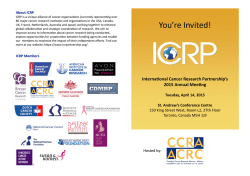
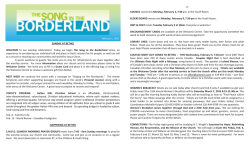
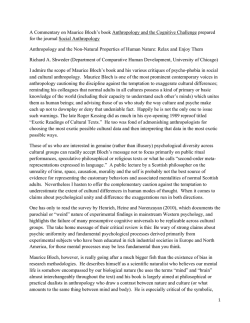
![Anthropology Seminar Series Spring 2015 [PDF 30.87KB]](http://s2.esdocs.com/store/data/000459047_1-7d84377bc849fc78a9376de82c187a04-250x500.png)
